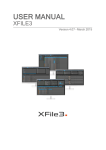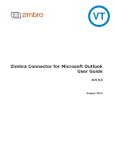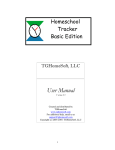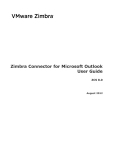Download User`s manual
Transcript
USER MANUAL XFILE3 Version 1.0 - July 2013 XFile3 - Version 1.00 - User Manual Copyright EVS Broadcast Equipment S.A.– Copyright © 2003-2013. All rights reserved. Disclaimer The information in this manual is furnished for informational use only and subject to change without notice. While every effort has been made to ensure that the information contained in this user manual is accurate, up-to-date and reliable, EVS Broadcast Equipment cannot be held responsible for inaccuracies or errors that may appear in this publication. Improvement Requests Your comments will help us improve the quality of the user documentation. Do not hesitate to send improvement requests, or report any error or inaccuracy on this user manual by e-mail to [email protected]. Regional Contacts The address and phone number of the EVS headquarters are usually mentioned in the Help > About menu in the user interface. You will find the full list of addresses and phone numbers of local offices either at the end of this user manual (for manuals on hardware products) or at the following page on the EVS website: http://www.evs.com/contacts. User Manuals on EVS Website The latest version of the user manual, if any, and other user manuals on EVS products can be found on the EVS download center, on the following webpage: http://www.evs.com/downloadcenter. I EVS Broadcast Equipment S.A. - July 2013 II XFile3 - Version 1.00 - User Manual Table of Contents TABLE OF CONTENTS III 1. 1 INTRODUCTION 1.1. About XFile3 1 1.2. Requirements 1 1.3. Compatibility 2 2. 3 INSTALLATION AND LICENSING 2.1. Software Installation 3 2.2. Licensing 7 3. 9 XFILE3 APPLICATION 3.1. Startup 3.1.1. Startup 9 3.2. Auto Archive Mode 10 3.2.1. Auto Archive Overview 10 3.2.2. Sources Zone 11 3.2.3. Templates Zone 12 3.2.4. Destinations Zone 13 3.2.5. Filters Zone 13 3.2.6. How to Create an Autobackup Rule 16 3.2.7. Job Zone 17 3.3. Archive Mode 20 3.3.1. Archive Overview 20 3.3.2. Source Zone 22 3.3.3. Templates Zone 24 3.3.4. Destinations Zone 25 3.3.5. How to Create Archive Jobs 26 3.3.6. Job Zone 26 3.4. Restore Mode Table of Contents 9 29 3.4.1. Restore Overview 29 3.4.2. Sources Zone 30 3.4.3. Destinations Zone 32 3.4.4. Options Zone 34 3.4.5. How to Create Restore Jobs 34 3.4.6. Job Zone 35 3.5. Monitoring Mode 37 3.5.1. Monitoring Overview 37 3.5.2. Hard Disk Zone 38 III EVS Broadcast Equipment S.A. - July 2013 3.5.3. Job Zone 3.6. About Window IV Issue 1.11.A 40 44 Table of Contents XFile3 - Version 1.00 - User Manual 1. Introduction 1.1. About XFile3 The purpose of this product is to automatically archive selected content from EVS servers to the transportable hard drives and enable restoring content from hard drives to EVS servers. The main users for XFile3 are: • LSM operators. • Producers and LSM Operator assistants. • Technical truck engineers. • Other Production users who manage archive and restore. The overall workflow implies two roles: 1. Archive existing clips from EVS servers to hard drives. 2. Restore existing files from hard drives to EVS servers. 1.2. Requirements Software Requirements • Gigabit Ethernet connectivity (up to 10GB Ethernet) • Microsoft.Net Framework 4.0 • Supported Multicam Versions: 11.02.X Hardware Requirements • 1. Introduction EVS XF[2] System 1 EVS Broadcast Equipment S.A. - July 2013 • OS: Window7 64bits or 32-bits • Bi-Core CPU Issue 1.11.A Workflow Requirements • 1.3. 2 It is advised to verify that the XSquare services are fully running before launching XFile3 operational software. Compatibility • XSecure V1.01.05 • XSquare V2.1.20 • XViewer V1.0.0 1. Introduction XFile3 - Version 1.00 - User Manual 2. Installation and Licensing 2.1. Software Installation To install XFile3, proceed as follows: 1. Run XFile3 installation package and then follow the steps of the Setup wizard and click Next. 2. Select "I accept the agreement" and click Next. 3. Select the destination directory to install the new software application and then click Next. The installer proposes a default path for the installation. i.e.: C:\Program Files(x86)\EVSBroadcast Equipment\XFile3. 2. Installation and Licensing 3 EVS Broadcast Equipment S.A. - July 2013 Issue 1.11.A 4. Select either mode to install. Two modes are available: Full install mode and Advanced install mode. ◦ Select Full install mode, all the components will be installed in Silent mode automatically. ◦ Select Advanced install mode, you can customize the components to be installed. The following steps are the installation process after selecting Advanced install mode. 5. Select the components to install, and then click Next. If you need to update XFile3 only, you can unselect the other three components and click Next. 4 2. Installation and Licensing XFile3 - Version 1.00 - User Manual 6. Click Browse to select a folder in which XFile3 shortcuts are saved, and then click Next. 7. Select Create a desktop icon to create a shortcut on the desktop, if unselect, the shortcut won’t display on the desktop. Click Next. 2. Installation and Licensing 5 EVS Broadcast Equipment S.A. - July 2013 Issue 1.11.A 8. Click Install and wait until the installation is completed. This can last a couple of minutes. After that, install XSquare Suite. 9. Select the first option to restart you computer now or select the second option to restart your computer later. The first option is highly recommended. And then click Finish to finish installation. 6 2. Installation and Licensing XFile3 - Version 1.00 - User Manual All applications are installed successfully. 2.2. Licensing The XFile3 software is managed by way of licenses codes managed with the XSecure application. The required license codes for XFile3 are the following: Application Module Summary 10 XFile 10 Base Module XFile3 User Application 60 XTAccess 10 Base Package Background XTAccess transfer agent 60 XTAccess 20 Transcoding Background XTAccess transcoding engine 170 XViewer 10 Base Package File Viewer Application Module When you need to add a new license code, or extend the validity of a temporary license code, you must use the XSecure Manager application. To add a new license code, proceed as follows: 1. Run the XSecure Manager application by double-clicking the XSecure Manager shortcut on your desktop as administrator. 2. Requesting license codes. a. Fill in the Customer information. b. Click on the Request button in the lower left corner of the window. This will generate an XML file that you must send to your EVS support representative c. Select the location where you would like to save that file, and click on the Save button. d. Send this file to your support contact at EVS support representative, specifying which new license codes or license code extensions you require. 3. Adding License codes. 2. Installation and Licensing 7 EVS Broadcast Equipment S.A. - July 2013 Issue 1.11.A a. After received another XML file containing the license codes or code extensions that you have requested. Copy that XML file in a directory that is visible by the computer where XSecure is installed (using a USB key for instance, or your LAN network) b. Click on the Import Key File button in XSecure window. The license codes will be automatically imported, and a dialog box confirms how many license codes have been successfully imported. 8 2. Installation and Licensing XFile3 - Version 1.00 - User Manual 3. XFile3 Application 3.1. Startup 3.1.1. Startup Double click the XFile3 icon window. to open the application. This opens an initialization The startup sequence will check the status of the background XSquare services as well as discover the available EVS XT and XS Servers on the same network as the XFile3 host computer. The Auto Archive Mode is selected by default at startup. If you re-launch XFile3 after auto-archive rules have been created, you are asked to make a choice to continue using the previous rules or clear then and start without any rules by way of a pop up window: Do you want to carry on using the same auto archive rules? • Click Yes to use the same auto archive rule, the old rules are retained. • Click No to remove the existing auto archive rules. Afterwards, pop up window will appear asking: The jobs in rule will be canceled, are you sure to continue? 3. XFile3 Application ◦ Select Yes to cancel all the existing jobs in rule and open XFile3. ◦ Select No to open XFile3, the old rule is existing. 9 EVS Broadcast Equipment S.A. - July 2013 Issue 1.11.A 3.2. Auto Archive Mode 3.2.1. Auto Archive Overview Auto Archive mode is the default page after startup. Auto Archive Mode is to automatically archive the source clips from the requested servers in the requested formats based on rules. Click to enter AutoArchive mode. The screen shot below shows various areas of the Auto Archive Main Window. 10 Area Name Description 1 Sources Zone Area that displays all the detected servers and their clip structure, including pages and banks. 2 Templates Zone Area that displays the templates available from the background running XSquare service manager. 3 Destinations Zone Area that displays all the destinations relative to the selected template. 3. XFile3 Application XFile3 - Version 1.00 - User Manual 3.2.2. Area Name Description 4 Filters Zone Area that displays all the filters options to add in the autobackup rule. 5 Create autobackup rule Button to create the autobackup rule. 6 Job Zone Area that displays all the created rules and all the job status Sources Zone The Sources Zone includes the following elements: • When select or unselect the parent level, all children will be select or unselect correspondingly. • Select the check box before servers and pages, or just select Select All to select all the clips in all the available servers. • Every server includes 10 pages (from 0-9), every page includes 9 banks (from 1-9), each bank includes 10 columns(from 0-9). 3. XFile3 Application 11 EVS Broadcast Equipment S.A. - July 2013 3.2.3. Issue 1.11.A • The server name on XFile3 UI is the SDTI network name of server, but if server name is blank in server,the serverID number will be displayed instead. • The total clip number can be displayed besides each server name, page or banks between brackets. Templates Zone The templates zone displays all the templates that can be used while auto archiving clips. Without Transcoding • - Avid MXF OPAtom • - EVS MXF • - MXF OP1a SMPTE • - QuickTime Movie With Transcoding • 1080i - AVC - Intra 100 MXF OP1a SMPTE • 1080i - Avid DNxHD VC -3 100Mbps MXF OP1a SMPTE • 1080i - DVCPro HD QTMov • 1080i - MJPEG 4Band XT1 EVS MXF • 1080i - ProRes 422 LT100 Mbps QTMov • 720p - AVC-Intra 100 MXF OP1a SMPTE • 720p - Avid DNxHD VC-3 100Mbps MXF OP1a SMPTE • 720p - DVCPro HD QTMov • 720p - MJPEG 4Band XT1 EVS MXF • 720p - ProRes 422 LT 100 Mbps QTMov How to Edit Template To edit template, select a reference template and click on the Edit button ,the TemplateEditor Window pops up, the user can modify the corresponding values. After modification, the user is permitted to perform a Save As and create it as a new template with a new name, or the user may click Cancel to abort this modification. It is currently not possible to delete any templates defined in the XFile3 version1. Note To get more information about editing template, click ?>Help on XSquare application. 12 3. XFile3 Application XFile3 - Version 1.00 - User Manual 3.2.4. Destinations Zone You must select the corresponding template from Templates Zone before choosing the required destination(s). How to Select Destination To select a destination path, the user clicks Browse button, the window named Browse For Folder pops up, select the desired destination path to write the archived clips to and click OK. The number of destination fields will vary from the different formats included in the Template Zone, For example, if the selected template includes destinations, then two fields will be displayed to be entered. Example: If a template has been selected since the last archive, it can still be applied in the next archive if has not been changed yet. 3.2.5. Filters Zone XFile3 allows users to define different filters in Auto Archive Mode. These filters are additional rule criteria to facilitate very complex jobs if desired. The Filters Zone includes five kinds of filters: • Pref Cam • Date&Time • Camera • Rating • Archive Flag • Keywords Grid 3. XFile3 Application 13 EVS Broadcast Equipment S.A. - July 2013 Issue 1.11.A Pref Cam The Pref Cams filter makes it possible to only include in the autobackup rule, the clips that were recorded from any camera defined as the first preferential camera (*) or on the second preferential camera (=). By default, no pref cam is selected, all cameras are included. Filter Description All cameras are both included in autobackup rule. Only the first and second preferential cameras are included in autobackup rule. Only the first preferential camera is included in autobackup rule. Only the second preferential camera is included in autobackup rule. Date&Time The filter makes it possible to include in the autoarchive rule, the clips that were created between the required date and time. By default, no date & time is selected. Filter Description The required date is selected with the format: date/month/year. The required time is selected with the format: hour:minute:second. To set the date, select the date button then the day of the month. to activate the calender, select the month and To set the time, select the time area and input the desired time. You can click Cancel to clear the defined date and time. Note Date & Time filter is based on Primary TC. 14 3. XFile3 Application XFile3 - Version 1.00 - User Manual Camera The camera filter makes it possible to select the clips to be included in the autoarchive. By default, the cameras are not selected, all cameras are included. The different cameras are shown as following: Filter Description A Backup only clips stored as A clips B Backup only clips stored as B clips C Backup only clips stored as C clips D Backup only clips stored as D clips E Backup only clips stored as E clips F Backup only clips stored as F clips Rating The Rating filter makes it possible to include the autoarchive the clips that were in the required rating level. By default, no rating is selected, all ratings are included. Rating Description Clips without rating Clips with rating one Clips with rating two Clips with rating three Archive Flag The Archive Flag filter makes it possible to include in the autoarchive the clips that were archived or not archived. By default, no archive flag is selected. : Only include the clips which are not flagged for archived. : Only include the clips which are flagged to be archived. Filter 3. XFile3 Application Meaning + All the clips will be archived, no archive flag selected + All the "not flagged to be archived" and "flagged to be archived" clips will be archived 15 EVS Broadcast Equipment S.A. - July 2013 Filter Issue 1.11.A Meaning + All the "flagged to be archived" clips will be archived + All the "not flagged to be archived" clips will be archived Keywords Grid The keywords filter makes it possible to include in the autoarchive only the clips togged with the selected keywords. By default, no keyword is selected. Click to activate Keyword Grid Window. All the keywords listed in this window are from all the detected servers. The list reflects all keywords that currently exist on the clips that exist. The user can select the required keywords in this window. 3.2.6. How to Create an Autobackup Rule To create an autoback rule, proceed as follows: 1. Select the source EVS Server and/or Page/Bank to autoarchive. The check boxes of the pages in the Sources Zone will be selected. 2. Select the template in the Templates Zone to specify the file format. 16 3. XFile3 Application XFile3 - Version 1.00 - User Manual 3. Select the destinations in the Destinations Zone to specify where clips will be archived. 4. Select different filters if desired. 5. Click Create autobackup rule. A new rule will be created and displayed in the Job Zone. All the clips in the selected pages within the defined filters will automatically be archived onto the specified destination. All the previously selected sources will be unselected automatically upon creation of the rule. 3.2.7. Job Zone After creating a new rule, the jobs will be displayed at the bottom of Auto Archive UI. You can click the arrow beside the rule to fold or unfold the jobs in the rule. You can also delete a rule or job. Rule Every rule includes several values you have defined before creating rules. Area Description Rule Name The name of rule is defined by a number automatically incremented. Source Displays the name of the selected server(s) . TemplateName Displays the chosen template. Destination Displays the selected destination. From Displays the starting date and time To Displays the ending data and time Pref Cam Displays the selected pref cam Camera Displays the selected cameras Rating Displays the selected rating Archive Displays the selected archive flag Keywords Displays the selected keywords in Keywords Grid 3. XFile3 Application 17 EVS Broadcast Equipment S.A. - July 2013 Issue 1.11.A Area Description Actions Area enables you to delete this rule Status Displays the number of completed jobs and matching jobs with the format: n completed jobs/n matching jobs. Job All the jobs meet the conditions of the specific rule will be displayed in the rule. Area Description Source Displays the LSMID of each job. ClipName Displays the name of the current archived clip. Format Displays the format which has been selected in the Template Zone. Destination Displays the destination where the archived clips will be stored. Remaining _ time Displays the remaining time of each job. Speed Displays the current archiving speed of each job. Status Displays the job status, refer to "Job Status" for more details. Action Enables you to delete this job or change the priority of the current job. Comments Displays the information from XSquare and XFile3. Job Status Six kinds of job status are available in Job Zone to specify the exact status of the current job. Job Status Description Waiting The job has been created and stored in the XFile3DataBase. Scheduled The job has been sent to XSquare and is scheduled to be proceeded. Running The job is processing. Completed The job is finished successfully. Failed The job is unsuccessful. cancelled The job has been cancelled. Note When a job is completed, the job will disappear from Job Zone, but you can see all the completed jobs in Monitoring Mode. 18 3. XFile3 Application XFile3 - Version 1.00 - User Manual The following diagram specifies the conversion between different status. How to Select Jobs All the selected jobs are highlighted in blue color. Four possible selection ways are available: • Click on one job, then the job will be selected. • Click on one job, then press CTRL from keyboard, and simultaneously click other jobs one by one to add to the selection, with this method, all the clicked jobs will be selected. • Click on one job, then press SHIFT from keyboard, and click any other jobs, then all the jobs between those two selected jobs will be selected. • Press CTRL+A to select all the jobs. How to Sort Jobs To sort a column in alphabetical or numerical order,unfold the jobs and click on the column label to display the arrow buttons and click again to invert the sorting. Note Destination and Action can't be sorted. How to Cancel Jobs To cancel jobs, proceed as follows: 1. Select the requested jobs. 2. Right click on the selected jobs and select Cancel. OR Click Cancel in Actions column. 3. The status of the job will be cancelled. 3. XFile3 Application 19 EVS Broadcast Equipment S.A. - July 2013 Issue 1.11.A Note Only the jobs with Waiting, Scheduled and Running status can be cancelled. How to Change Job Priority Changing job priority means moving the selected job to the first position in the Scheduled job queue for the job to be processed in priority. To change job priority, proceed as follows: 1. Select the requested jobs. 2. Right click on the selected jobs and select Process ASAP. OR Click Process ASAP in Actions column. 3. The job will be processed soon with high priority. Note Only the priority of jobs with the Scheduled status can be changed. 3.3. Archive Mode 3.3.1. Archive Overview Archive Mode is used to archive the source clips from the requested servers to the requested formats and destinations manually. Click to enter Archive mode. The screen shot below shows various areas of Archive Main Window. 20 3. XFile3 Application XFile3 - Version 1.00 - User Manual Area Name Description 1 Sources Zone Area that displays all the detected servers and their clip structures, including the pages and banks 2 Templates Zone Area that displays the templates available from XSquare. 3 Destinations Zone Area that displays all the destinations matching the selected template. 4 Create Job Button to create archive job. 5 Job Zone Area that displays all the created rules and all the job status. 3. XFile3 Application 21 EVS Broadcast Equipment S.A. - July 2013 3.3.2. Issue 1.11.A Source Zone Server List The Sources Zone includes the following elements: 22 • When select or unselect the parent level, all children will be select or unselect correspondingly. • Select the check box before servers and pages, or just select Select All to select all the clips in all the available servers. • Every server includes 10 pages (from 0-9), every page includes 9 banks (from 1-9), each bank includes 10 columns(from 0-9). • The server name on XFile3 UI is the SDTI network name of server, but if server name is blank in server,the serverID number will be displayed instead. 3. XFile3 Application XFile3 - Version 1.00 - User Manual • The total clip number can be displayed besides each server name, page or banks between brackets. Sources List Sources List only displays the clips from the specific banks or pages in the selected servers, it includes the following elements: • Select the check box before LSMID to select all the clips in the specific banks or pages of the selected servers. • Each clip includes some metadata: LSMID, Name, Keywords(from1-5), Archive Destinations. Clip Information Description LSM ID Displays ID assigned to the clips using its page, bank, row and camera number. Name Displays the name assigned to the clip. Keyword1 Displays the first keyword assigned to the clip. Keyword2 Displays the second keyword assigned to the clip. Keyword3 Displays the third keyword assigned to the clip. Keyword4 Displays the fourth keyword assigned to the clip. Keyword5 Displays the fifth keyword assigned to the clip. Archive Destination Displays the path where the backup file is located on local disks, if backed up previously. 3. XFile3 Application 23 EVS Broadcast Equipment S.A. - July 2013 Issue 1.11.A How to Sort Clips To sort a column in alphabetical or numerical order, click on the column label to display the arrow button and click again to invert the sorting. How to Search Clips To search clips, you only need to input the characters whose name includes this character in the Quick Search Tool, all the clips include the characters will display on Sources List. To clear the search filter, you can click in the Quick Search Tool. Note The above Source List area is the same as that in Restore Mode. 3.3.3. Templates Zone The templates zone displays all the templates you will use while archiving clips, after archiving, all the archived clips can be transferred to the format you selected in the Template Zone. Without Transcoding • - Avid MXF OPAtom • - EVS MXF • - MXF OP1a SMPTE • - QuickTime Movie With Transcoding 24 • 1080i - AVC - Intra 100 MXF OP1a SMPTE • 1080i - Avid DNxHD VC -3 100Mbps MXF OP1a SMPTE • 1080i - DVCPro HD QTMov • 1080i - MJPEG 4Band XT1 EVS MXF 3. XFile3 Application XFile3 - Version 1.00 - User Manual • 1080i - ProRes 422 LT100 Mbps QTMov • 720p - AVC-Intra 100 MXF OP1a SMPTE • 720p - Avid DNxHD VC-3 100Mbps MXF OP1a SMPTE • 720p - DVCPro HD QTMov • 720p - MJPEG 4Band XT1 EVS MXF • 720p - ProRes 422 LT 100 Mbps QTMov How to Edit Template To edit template, select a reference template and click on the Edit button ,the TemplateEditor Window pops up, the user can modify the corresponding values. After modification, the user is permitted to perform a Save As and create it as a new template with a new name, or the user may click Cancel to abort this modification. It is currently not possible to delete any templates defined in the XFile3 version1. Note To get more information about editing template, click ?>Help on XSquare application. 3.3.4. Destinations Zone You must select the corresponding template from Templates Zone before choosing the required destination(s). How to Select Destination To select a destination path, the user clicks Browse button, the window named Browse For Folder pops up, select the desired destination path to write the archived clips to and click OK. The number of destination fields will vary from the different formats included in the Template Zone, For example, if the selected template includes destinations, then two fields will be displayed to be entered. Example: 3. XFile3 Application 25 EVS Broadcast Equipment S.A. - July 2013 Issue 1.11.A If a template has been selected since the last archive, it can still be applied in the next archive if has not been changed yet. 3.3.5. How to Create Archive Jobs To create archive jobs, proceed as follows: 1. Select the source clips to archive. The check boxes of the pages in the Sources Zone will be selected. You can select the clips to be archived in the Source List by ticking the check box. 2. Select the template in the Templates Zone to backup the clips in the selected format. 3. Select the destinations in the Destinations Zone to store the archived clips in the local destinations. 4. Click Create Job. All the jobs will be created and displayed in the Job Zone. 3.3.6. Job Zone After create jobs, all the jobs will display at the bottom of Archive UI. Job All the jobs created manually are displayed on the Job Zone. 26 Area Description Source Displays the LSMID of each job ClipName Displays the name of the current archived clip. 3. XFile3 Application XFile3 - Version 1.00 - User Manual Area Description Format Displays the format which has been selected in the Template Zone. Destination Displays the destination where the archived clips will be stored. Remaining _ time Displays the remaining time of each job. Speed Displays the current archiving speed of each job. Status Displays the job status, refer to "Job Status"for more details. Action Enables you to delete this job or change the priority of the current job. Comments Displays the information from XSquare and XFile3. Job Status Six kinds of job status are available in Job Zone to specify the exact status of the current job. Job Status Description Waiting The job has been created and stored in the XFile3DataBase. Scheduled The job has been sent to XSquare and is scheduled to be proceeded. Running The job is processing. Completed The job is finished successfully. Failed The job is unsuccessful. cancelled The job has been cancelled. Note When a job is completed, the job will disappear from Job Zone, but you can see all the completed jobs in Monitoring Mode. The following diagram specifies the conversion between different status. 3. XFile3 Application 27 EVS Broadcast Equipment S.A. - July 2013 Issue 1.11.A How to Select Jobs All the selected jobs are highlighted in blue color. Four possible selection ways are available: • Click on one job, then the job will be selected. • Click on one job, then press CTRL from keyboard, and simultaneously click other jobs one by one to add to the selection, with this method, all the clicked jobs will be selected. • Click on one job, then press SHIFT from keyboard, and click any other jobs, then all the jobs between those two selected jobs will be selected. • Press CTRL+A to select all the jobs. How to Sort Jobs To sort a column in alphabetical or numerical order, click on the column label to display the arrow buttons and click again to invert the sorting. How to Cancel Jobs To cancel jobs, proceed as follows: 1. Select the requested jobs. 2. Right click on the selected jobs and select Cancel. OR Click Cancel in Actions column. 3. The status of the job will be cancelled. Note Only the jobs with Waiting, Scheduled and Running status can be cancelled. How to Change Job Priority Changing job priority means moving the selected job to the first position in the Scheduled job queue for the job to be processed in priority. To change job priority, proceed as follows: 1. Select the requested jobs. 2. Right click on the selected jobs and select Process ASAP. 28 3. XFile3 Application XFile3 - Version 1.00 - User Manual OR Click Process ASAP in Actions column. 3. The job will be processed soon with high priority. Note Only the priority of jobs with the Scheduled status can be changed. 3.4. Restore Mode 3.4.1. Restore Overview Click to enter Restore mode. Clips can be restored from a local destination to any EVS video server on the network. The screen shot below shows various areas of Restore Main Window. Area Name Description 1 Sources Zone Area that displays all the sources in the detected destinations, including the local path, folders,subfolders and clips' metadata in the selected destination or folders. Area that displays all clips from the selected directories of the selected hard drives. 2 Destinations Area that displays all the detected servers and their structures, Zone including the pages, banks and the metadata of all the clips. 3 Option Zone 3. XFile3 Application Area that displays the copy type. 29 EVS Broadcast Equipment S.A. - July 2013 3.4.2. Issue 1.11.A Area Name Description 4 Create Job Button to create restore jobs. 5 Job Zone Area that display all the created jobs and status.. Sources Zone Hard Drive List Hard Drive List includes the following elements: 30 • Select the check box before hard drive or folders to select the clips in the selected hard drive. • Click on one folder, then press SHIFT from keyboard, and click any other folders, then all the folders between those two selected folders will be selected. • Each includes several folders and the subfolders. • Click Refresh button to refresh the detected hard drives. 3. XFile3 Application XFile3 - Version 1.00 - User Manual Sources List Sources List only displays the clips from the specific banks or pages in the selected servers, it includes the following elements: • Select the check box before LSMID to select all the clips in the specific banks or pages of the selected servers. • Each clip includes some metadata: LSMID, Name, Keywords(from1-5), TC IN, session metadata, path and Restore Destinations. Clip Information Description LSM ID Displays ID assigned to the clips using its page, bank, row and camera letter. Name Displays the name assigned to the clip. Keyword1 Displays the first keyword assigned to the clip. Keyword2 Displays the second keyword assigned to the clip. Keyword3 Displays the third keyword assigned to the clip. Keyword4 Displays the fourth keyword assigned to the clip. Keyword5 Displays the fifth keyword assigned to the clip. TC IN Displays the TC IN assigned to the clip. Session Metadata Session metadata includes eight kinds of metadata assigned to the clip: SessionName, SessionDate, SessionSport, SessionCompetition, SessionCompetitionLevel, SessionLocation, SessionTeamA, SessionTeamB. Path Displays the file's path. Restore Destination Displays the path where the clip will be restored, or has been restored previously. 3. XFile3 Application 31 EVS Broadcast Equipment S.A. - July 2013 Issue 1.11.A How to Search Clips To search clips, you only need to input the characters whose name includes this character in the Quick Search Tool, all the clips include the characters will display on Sources List. To clear the search filter, you can click 3.4.3. in the Quick Search Tool. Destinations Zone Server List The Server List includes the following elements: 32 • Select the check box before servers and pages, or just select Select All to select all the positions in all the available servers. • Every server includes 10 pages (from 0-9), every page includes 9 banks (from 1-9), each bank includes 10 columns(from 0-9). • The server name on XFile3 UI is the SDTI network name of server, but if server name is null in server, the serverID number will be displayed instead. • The total clip number can be displayed besides each server name, page or banks between brackets. 3. XFile3 Application XFile3 - Version 1.00 - User Manual Destination List The Destination List only displays the positions from the specific banks or pages in the selected servers, it includes the following elements: • Select the requested server, page or bank. ◦ If the selection is from one server, all the positions in the selected server will be displayed at the right side of Destinations Zone. And then you can select one of the available position by ticking the check box as the starting point to restore clips, XFile3 restores from the first available position if you don't select a starting point. ◦ If the selection is from more than one servers, all the positions in the selected servers will not be displayed out. And then you do not need to select a specifc starting point, all the clips from the EVS servers will restored from the first available position and restore the others one by one, all the selected clips will be restore respectively in all the selected servers. • Each position includes some metadata: LSMID, name. • A radio button is displayed in front of the empty positions. 3. XFile3 Application 33 EVS Broadcast Equipment S.A. - July 2013 3.4.4. Issue 1.11.A Options Zone Copy Type You can choose to select the copy types, two copy types are available Copy Type Description Continuous The clips to be restored will be restored to the available positions one by one from the selected starting point, taking into consideration the filter options. Same Topology The topology position of all the restored clips will keep the same with that in EVS server. If the position to be restored is unavailable, the clip will not be restored. The first clip must correspond to the same page in EVS server, if not, the clip will not be restored, and other clips will keep the same topology as well. Camera Filter You can choose to restore the specific camera positions only. Only the clips with the selected cameras will be displayed, all clips in the selected folders are displayed by default. 3.4.5. Camera Description A Restore only Camera A clips. B Restore only Camera B clips. C Restore only Camera C clips. D Restore only Camera D clips. E Restore only Camera E clips. F Restore only Camera F clips. How to Create Restore Jobs To create restore jobs, proceed as follows: 1. Select the source clips to restore. The check boxes before the required clips in Sources Zone will be selected. 2. Select one starting point in Destinations Zone to store the restored clips in the EVS video server if needed. If you have selected more than one servers, you don't need to select a specific starting point. 3. Select the Copy Type if needed. By default, Continuous is selected. 4. Select Camera Filter if needed. By default, no camera filter is selected. 5. Click Create Job. All the jobs will be displayed in the Job Zone. 34 3. XFile3 Application XFile3 - Version 1.00 - User Manual 3.4.6. Job Zone After creating job, the jobs will be displayed at the bottom of Restore UI. Area Description Sources Displays all the selected clips Restore Destination Displays the restore positions on the EVS video server ClipName Displays the name of the current restored clip. Remaining _time Displays the remaining time of each job. Speed Displays the current archiving speed of each job. Status Displays the job status, refer to"Job Status" for more details. Transcoded This area displays the transcoded status of the restored clip. • With icon: the clip is transcoded. • Without icon: the clip is not transcoded. Action This area enables you to delete this job. Comments Displays the information from XSquare. Job Status Six kinds of job status are available in Job Zone to specify the exact status of the current job. Job Status Description Waiting The job has been created and stored in the XFile3DataBase. Scheduled The job has been sent to XSquare and is scheduled to be proceeded. Running The job is processing. Completed The job is finished successfully. Failed The job is unsuccessful. Cancelled The job has been cancelled. Note When a job is completed, the job will disappear from Job Zone, but you can see all the completed jobs in Monitoring Mode. 3. XFile3 Application 35 EVS Broadcast Equipment S.A. - July 2013 Issue 1.11.A The following diagram specifies the conversion between different status. How to Select Jobs All the selected jobs are highlighted in blue color. Four possible selection ways are available: • Click on one job, then the job will be selected. • Click on one job, then press CTRL from keyboard, and simultaneously click other jobs one by one to add to the selection, with this method, all the clicked jobs will be selected. • Click on one job, then press SHIFT from keyboard, and click any other jobs, then all the jobs between those two selected jobs will be selected. • Press CTRL+A to select all the jobs. How to Sort Jobs To sort a column in alphabetical or numerical order, click on the column label to display the arrow button and click again to invert the sorting. Note Transcode and Action columscan't be sorted. How to Cancel Jobs To cancel jobs, proceed as follows: 1. Select the requested jobs. 2. Right click on the selected jobs and select Cancel. OR Click Cancel in Actions column. 3. The status of the job will be cancelled. 36 3. XFile3 Application XFile3 - Version 1.00 - User Manual Note Only the jobs with Waiting, Scheduled and Running status can be cancelled. How to Change Job Priority Changing job priority means moving the selected job to the first position in the Scheduled job queue for the job to be processed in priority. To change job priority, proceed as follows: 1. Select the requested jobs. 2. Right click on the selected jobs and select Process ASAP. OR Click Process ASAP in Actions column. 3. The job will be processed soon with high priority. Note Only the priority of jobs with the Scheduled status can be changed. 3.5. Monitoring Mode 3.5.1. Monitoring Overview Click to enter monitoring mode. In Monitoring mode, you can see all the available hard disks and all the tasks in both Archive and Restore Modes. 3. XFile3 Application 37 EVS Broadcast Equipment S.A. - July 2013 3.5.2. Issue 1.11.A Area Name Description 1 Hard Disk Zone Area to display all the detected hard disks. 2 Task Zone Area to display all the tasks in Archive and Restore modes. Hard Disk Zone Hard Disks Hard Disks zone displays all the hard disks detected by XFile3. To eject the hard disk, click on 38 . 3. XFile3 Application XFile3 - Version 1.00 - User Manual Storyboard What Is a Storyboard A storyboard is a list of clip's content that is delivered with the current selected local hard drive. When the backup jobs are created, the operator can create it as a HTML file and store in the desirable position. How to Create Storyboard To create storyboard, proceed as follows: 1. Select the source hard drive. 2. Click Create Storyboard, when StoryboardOptionWindow pops up, select the choose for a requested path to store the storyboard. 3. Click OK, the storyboard will be stored in the requested path. To open this storyboard, you only need to open the file named Storyboard.html by web browser. Storyboard displays the following elements of each clip: Clip Information Description Clip ID Displays the ID assigned to the clip. Clip Name Displays the name assigned to the clip. TC IN Displays the IN point of the clip assigned to the clip. Duration Displays the duration of the clip from IN to OUT assigned to the clip. Keyword1 Displas the first keyword assigned to the clip. Keyword2 Displas the second keyword assigned to the clip. Keyword3 Displas the third keyword assigned to the clip. 3. XFile3 Application 39 EVS Broadcast Equipment S.A. - July 2013 Issue 1.11.A Clip Information Description Keyword4 Displas the fourth keyword assigned to the clip. Keyword5 Displas the fifth keyword assigned to the clip. Creation Date Time Displays the Date when the clip was created. Backup Date Time Displays the Date when the clip was backkuped. Metadata Filename Displays the EVS XML file assigned to the clip. File Size 3.5.3. Displays the file size assigned to the clip. Job Zone All the jobs in Monitoring mode synchronize those in AutoArchive, Archive and Restore modes, any changes made in Monitoring mode will happen in Monitoring mode as well. Job Zone displays all the tasks in Archive (AutoArchive & Archive) and Restore modes. Selection Description + No tasks will be displayed out. + All tasks in Archive(autoarchive & archive) and Restore modes will be displayed out. + All tasks in Archive(autoarchive & archive) mode will be displayed out. + All tasks in Restore mode will be displayed out. Job Zone displays different metadata about each job. 40 3. XFile3 Application XFile3 - Version 1.00 - User Manual Metadata Description Type : Archive task(Archive & AutoArchive) : Restore tasks LSM_ID Displays ID assigned to the clips using its page, bank, row and camera number. Name Displays the name assigned to the clip. Destination Displays the path where the clip is archived or restore. Format Displays the format of the current archived or restored clips. Remaining_ time Displays the remaining time of each job. Status Displays the job status, refer to "Job Status"for more details. Actions Enables you to delete this job or change the priority of the current job. Job Status Six kinds of job status are available in Job Zone to specify the exact status of the current job. Job Status Description Waiting The job has been created and stored in DataBase. Scheduled The job has been sent to XSquare and is scheduled to be proceeded. Running The job is processing. Completed The job is finished successfully. Failed The job is unsuccessful. Cancelled The job has been cancelled. The following diagram specifes the conversion between different status. How to Select Jobs All the selected jobs are highlighted in blue color. Four possible selection ways are available: 3. XFile3 Application 41 EVS Broadcast Equipment S.A. - July 2013 Issue 1.11.A • Click on one job, then the job will be selected. • Click on one job, then press CTRL from keyboard, and simultaneously click other jobs one by one to add to the selection, with this method, all the clicked jobs will be selected. • Click on one job, then press SHIFT from keyboard, and click any other jobs, then all the jobs between those two selected jobs will be selected. • Press CTRL+A to select all the jobs. How to Search Clips To search clips, you only need to input the characters whose name includes this character in the Quick Search Tool, all the clips include the characters will display on Sources List. To clear the search filter, you can click in the Quick Search Tool. How to Sort Jobs To sort a column in alphabetical or numerical order, click on the column label to display the arrow button and click again to invert the sorting. Note Action can't be sorted.. How to Cancel Jobs To cancel jobs, proceed as follows: 1. Select the requested jobs. 2. Right click on the selected jobs and select Cancel. OR Click Cancel in Actions column. 3. The status of the job will be cancelled. Note Only the jobs with Waiting, Scheduled and Running status can be cancelled. 42 3. XFile3 Application XFile3 - Version 1.00 - User Manual How to Change Job Priority Changing job priority means moving the selected job to the first position in the Scheduled job queue for the job to be processed in priority. To change job priority, proceed as follows: 1. Select the requested jobs. 2. Right click on the selected jobs and select Process ASAP. OR Click Process ASAP in Actions column. 3. The job will be processed soon with high priority. Note Only the priority of jobs with the Scheduled status can be changed. How to Maintain Database Click to enter Database Monitor window. The window enables you to do the following operations: • See the size of DB file • See the number of all jobs • Delete obsolete jobs: When click on Delete obsolete jobs, all the obsolete jobs will be deleted. • Delete all jobs: When click on Delete all jobs, all the jobs will be deleted. • Backup database and logs: When click on Backup database and logs, all XFile3 database and logs will be backuped. 3. XFile3 Application 43 EVS Broadcast Equipment S.A. - July 2013 Issue 1.11.A How to Delete Obsolete Jobs To delete obsolete jobs, click on Delete obsolete jobs. What Are Obsolete Jobs Obsolete jobs include: • Cancelled jobs • Failed jobs • The source clips related to the jobs have been deleted. How to Delete All Jobs To delete all jobs, click on Delete all jobs. XFile3 will restart after deleting all jobs. What Are All Jobs All jobs include all the jobs created from both autoarchive, archive and restore modes. How to Backup Database and Logs To backup database and logs, click on Backup database and logs. How to Clear Finished Jobs To clear all the finished jobs, click on Clear Finished Jobs . What Are Finished Jobs Finished jobs include the job with the following status: 3.6. • Completed • Failed • Cancelled About Window To view product information of the current software version, you just need to click and then a message box pops up. 44 , 3. XFile3 Application XFile3 - Version 1.00 - User Manual Click on User’s manual link to open the PDF version of the current software version. 3. XFile3 Application 45 EVS Broadcast Equipment S.A. - July 2013 46 3. XFile3 Application



































































